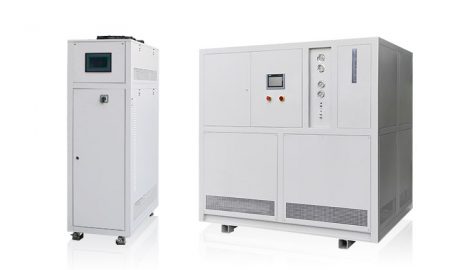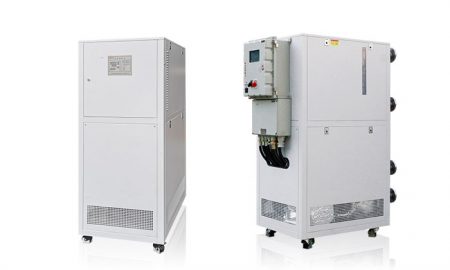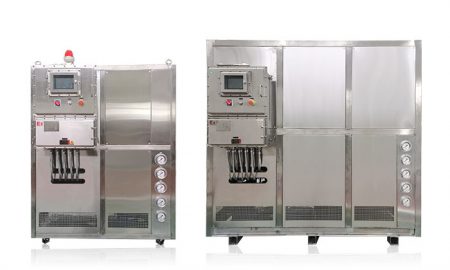Temperature Control Unit Heating Cooling
Contacte-nos hoje para obter a solução perfeita de controlo da temperatura
Temperature control unit heating cooling is a device that can realize refrigeration, heating and temperature control functions at the same time. It usually consists of a refrigeration cycle system, a heating system and a control part. The following will introduce in detail the principles, structure, characteristics, application scenarios and future development trends of the system.
1. Principle of temperature control unit heating cooling
The principle is mainly based on the law of thermodynamics, that is, heat will not transfer from low-temperature objects to high-temperature objects by itself, but will transfer from high-temperature objects to low-temperature objects. The system transfers heat from low-temperature objects to high-temperature objects through the synergistic effect of compressors, condensers, expansion valves, evaporators and other components, thereby achieving cooling and heating effects. At the same time, precise control of temperature can be achieved by controlling the operation of the compressor refrigeration cycle system and heating system.
2. Structure of temperature control unit heating cooling
Temperature control unit heating cooling is mainly composed of refrigeration cycle system, heating system and control part.
Refrigeration cycle system: It is mainly composed of compressor, condenser, expansion valve and evaporator. The compressor compresses low-temperature and low-pressure gas into high-temperature and high-pressure gas, thereby providing sufficient energy for cooling and heating. The condenser is used to cool the high-temperature and high-pressure gas compressed by the compressor into a liquid. The expansion valve controls the pressure and flow of the liquid, while the evaporator is used to absorb heat and transfer it to the object to be cooled.
Heating system: Mainly composed of electric heaters, heat exchangers, etc. Electric heaters convert electrical energy into thermal energy and transfer the heat to the object to be heated through a heat exchanger.
Control part: mainly composed of temperature sensors, controllers, actuators, etc. The temperature sensor detects the temperature of the system. The controller outputs a control signal to the actuator based on the comparison between the set temperature and the actual temperature. The actuator controls the operation of the compressor refrigeration cycle system and heating system to achieve precise temperature control.

3. Characteristics of temperature control unit heating cooling
Temperature control unit heating cooling is a powerful device with the following characteristics:
Powerful functions: The system can realize cooling, heating and temperature control functions to meet different scenarios and needs.
High efficiency and energy saving: The system adopts advanced thermodynamic principles, which can effectively utilize energy and achieve high efficiency and energy saving.
Easy operation: The operation of the system is simple and convenient. You only need to press the corresponding button to realize function conversion and temperature control.
Wide scope of application: The system can be applied to a variety of different occasions, such as commercial refrigeration, refrigeration, air conditioning and other fields, and can also be used for heating and cooling in industrial production processes.
Convenient maintenance: The maintenance of the system is convenient and simple, and only regular inspection and maintenance are required to ensure the normal operation of the equipment.
4. Application scenarios of temperature control unit heating cooling
As a powerful device, temperature control unit heating cooling has a wide range of application scenarios and is mainly used in the following aspects:
Commercial refrigeration equipment: Commercial refrigeration, refrigeration, air conditioning and other fields are one of the main application areas. Commercial refrigeration equipment requires frequent cooling and heating operations and consumes a large amount of energy, and the refrigeration and heating temperature control system just meets this demand.
Industrial production: Various heating and refrigeration equipment are needed in the industrial production process, and the refrigeration and heating temperature control system can just meet this demand. The use of refrigeration and heating temperature control systems in industrial production processes can effectively improve production efficiency and reduce energy consumption.
Scientific research experiments: In scientific research experiments, experimental operations such as temperature control and precise temperature adjustment are often required, and the refrigeration and heating temperature control system can achieve precise temperature control and adjustment to meet the needs of experiments.
Home refrigeration: In the home, the refrigeration, heating and temperature control system can also play a big role. Especially in high-temperature weather in summer, families need to perform frequent refrigeration operations, and the use of refrigeration and heating temperature control systems can achieve efficient and energy-saving refrigeration effects.
5. Future development trends of temperature control unit heating cooling
With the improvement of environmental awareness and the restriction of energy consumption, the future development trend will be towards a more efficient, energy-saving, environmentally friendly and sustainable direction. At the same time, with the continuous advancement and innovation of science and technology, the application fields will be more extensive in the future, and the technology will be more mature and advanced. For example, with the development of artificial intelligence technology, artificial intelligence technology may be introduced into refrigeration and heating temperature control systems in the future to achieve intelligent control and management, improve equipment operating efficiency and reduce energy consumption. At the same time, with the continuous development of new energy technologies, future refrigeration and heating temperature control systems may use new energy technologies, such as solar energy and wind energy, to achieve more environmentally friendly and sustainable operations. In short, future development will continue to develop in the direction of intelligence, efficiency and environmental protection, providing better services and more advanced technical support for applications in different fields.
Correio eletrónico: info@lneya.com ID WeChat: +8615251628237 WhatsApp: +86 17851209193

Sistemas de arrefecimento e aquecimento (série SUNDI)
Gama de controlo de temperatura: -120°C a +350°C
Application: Various Reactors (Microchannels, Glass, Jacketed Reactors, etc.), Distillation or Extraction System, Laboratory, University, Research Institute, Aerospace, Automotive Industry, Semiconductor and Electrical Test, Chemical, Pharmaceutical, Petrochemical, Biochemical, Medical, Hospital, R&D Workshop, Aerospace, Biological and Other Industries.
| Faixa de temperatura | Série -10 ~ +150°C | Série -25 ~ +200°C | Série -25 ~ +300°C | Série -45 ~ +250°C | Série -45 ~ +300°C | Série -60 ~ +250°C | Série -60 ~ +300°C | Série -70 ~ +250°C | Série -80 ~ +250°C | Série -90 ~ +250°C | Série -100 ~ +100°C | -25 ~ +200°C uma máquina para dois reactores | -40 ~ +200°C uma máquina para dois reactores |
| Capacidade de arrefecimento | 1,5 ~ 15kW | 1 ~ 200kW | 1 ~ 200kW | 0,45 ~ 200kW | 0,9 ~ 25kW | 0,25 ~ 60kW | 0,75 ~ 25kW | 0,4 ~ 15kW | 0,3 ~ 80kW | 0,2 ~ 80kW | 0,45 ~ 80kW | até 10*2kW | até 10*2kW |

Sistemas de arrefecimento e aquecimento (série WTD)
(Reactores de canal micro / tubo especializados)
Gama de controlo de temperatura: -70°C a +300°C
Design especializado para micro canal (pequena capacidade de retenção de líquido, forte capacidade de troca de calor, sistema de circulação de alta queda de pressão)
| Faixa de temperatura | -70°C ~ +300°C | -45°C ~ +250°C | -70°C ~ +200°C |
| Capacidade de arrefecimento | 1,1 ~ 7,5kW | 1,5 ~ 5,5kW | 11 ~ 50kW |

Circuladores de arrefecimento e aquecimento
Gama de controlo de temperatura: -45°C a +250°C
Application: Various Reactors (Microchannels, Glass, Jacketed Reactors, etc.), Distillation or Extraction System, Laboratory, University, Research Institute, Aerospace, Chemical, Pharmaceutical, Petrochemical, Biochemical, Medical, Hospital, R&D Workshop, Aerospace, Biological and Other Industries.
| Faixa de temperatura | Série -25°C ~ +200°C | Série -45°C ~ +250°C |
| Capacidade de arrefecimento | 1 ~ 15kW | 0,25 ~ 15kW |

Circuladores de aquecimento
Gama de controlo de temperatura: +50°C a +300°C
Nota: A série UC pode controlar a temperatura do meio de transferência de calor. A série UST pode não só controlar a temperatura do meio de transferência de calor, mas também controlar a temperatura do material de reação.
| Faixa de temperatura | +50°C ~ +170°C (série UC) | +50°C ~ +300°C (série UC) | +50°C ~ +300°C (série UST) |
| Capacidade de aquecimento | 5,5 ~ 15kW | 3,5 ~ 130kW | 3,5 ~ 95kW |

TCU Sistema de controlo da temperatura de multi-reactores
Gama de controlo de temperatura: -120°C a +250°C
Application: Various Reactors (Microchannels, Glass, Jacketed Reactors, etc.), Distillation or Extraction System, Laboratory, University, Research Institute, Aerospace, Chemical, Pharmaceutical, Petrochemical, Biochemical, Medical, Hospital, R&D Workshop, Aerospace, Biological and Other Industries.
| Faixa de temperatura | Série -45°C ~ +250°C | Série -120°C ~ +250°C | Sistema de controlo de temperatura personalizado | RT+10°C ~ +135°C |
| Capacidade de aquecimento | 25 ~ 80kW | 25 ~ 80kW | Personalizado | 25 ~ 300kW |
 LNEYA
LNEYA
 简体中文
简体中文


















































































